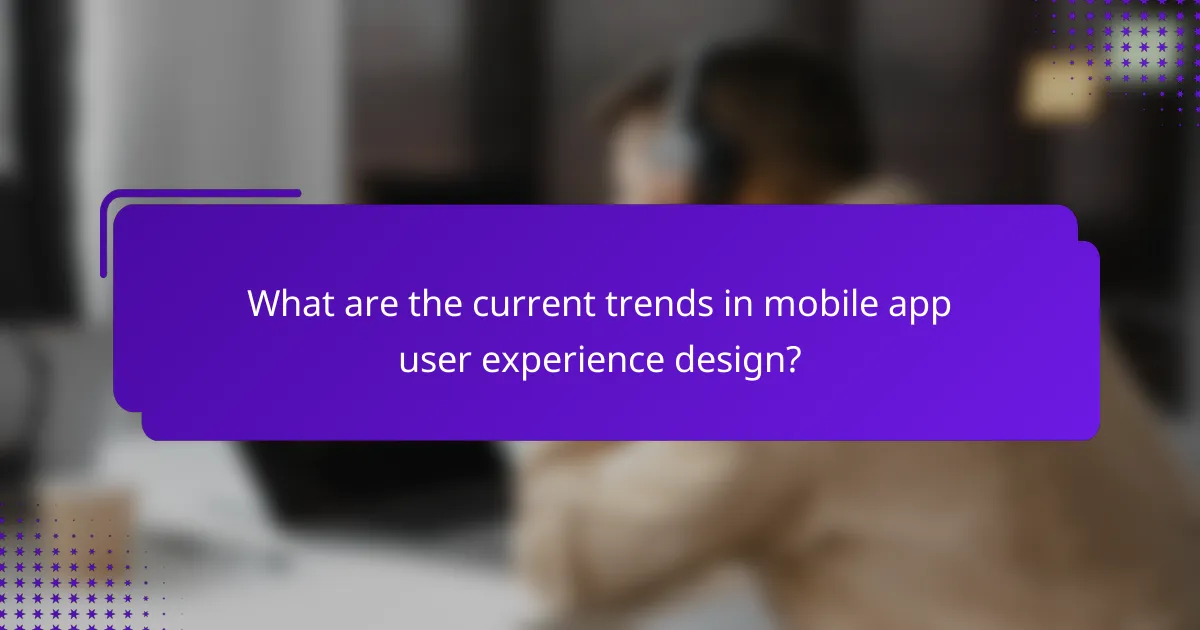Mobile app user experience design is evolving with key trends such as personalization, dark mode, and minimalistic interfaces. Personalization enhances engagement by tailoring content to user preferences, while dark mode reduces eye strain and conserves battery life. Minimalistic interfaces streamline navigation and lower cognitive load, making essential tasks more accessible. Additionally, the rise of voice user interfaces and gesture-based navigation is transforming user interactions, promoting intuitive app experiences. Future developments will emphasize real-time adaptability, augmented reality, and increased focus on accessibility and data privacy, reflecting a commitment to user-centered design principles. Best practices for designers include understanding user needs, ensuring intuitive navigation, maintaining consistency, and optimizing performance for a seamless experience.

What are the current trends in mobile app user experience design?
Current trends in mobile app user experience design include a focus on personalization, dark mode, and minimalistic interfaces. Personalization enhances user engagement by tailoring content to individual preferences. Dark mode reduces eye strain and conserves battery life on OLED screens, becoming increasingly popular among users. Minimalistic interfaces streamline navigation and reduce cognitive load, allowing users to focus on essential tasks. Additionally, voice user interfaces are gaining traction, making apps more accessible. Gesture-based navigation is also on the rise, providing intuitive user interactions. These trends reflect a shift towards creating more user-centered and efficient app experiences.
How are user expectations evolving in mobile app design?
User expectations in mobile app design are evolving towards greater personalization and seamless user experiences. Users now demand apps that understand their preferences and behavior. They expect intuitive interfaces that require minimal learning. Speed and performance are crucial; users favor apps that load quickly and respond instantly. Additionally, users are increasingly concerned about privacy and data security. They prefer apps that offer transparency regarding data usage. The rise of voice and gesture controls is also shaping expectations for more natural interactions. User feedback is becoming essential in the design process, influencing updates and new features. Overall, the focus is shifting towards user-centric design that prioritizes satisfaction and engagement.
What factors are driving changes in user expectations?
Technological advancements are driving changes in user expectations. Users now expect faster performance and seamless interactions. The rise of artificial intelligence has increased demand for personalized experiences. Mobile devices have become more powerful, enabling complex functionalities. Social media influences user preferences and shapes expectations for engagement. Data privacy concerns are prompting users to seek transparency and control. User feedback is increasingly shaping app development, leading to iterative improvements. Market competition pushes companies to innovate continually to meet evolving user demands.
How do demographics influence user experience preferences?
Demographics significantly influence user experience preferences by shaping user expectations and behaviors. Age impacts technology familiarity; younger users often prefer intuitive interfaces. Gender can affect design preferences, with studies showing women favoring aesthetics more than men. Cultural background influences usability; for instance, users from collectivist cultures may prefer social features. Income levels can dictate access to technology, impacting user engagement. Education level affects users’ ability to navigate complex features. Research shows that tailored experiences based on demographic data enhance user satisfaction and retention. Understanding demographics allows designers to create more effective and appealing mobile app experiences.
What innovations are shaping mobile app user experience design?
Innovations shaping mobile app user experience design include artificial intelligence, augmented reality, and voice user interfaces. Artificial intelligence enhances personalization by analyzing user behavior and preferences. Augmented reality provides immersive experiences, allowing users to interact with digital elements in real-world environments. Voice user interfaces enable hands-free navigation, improving accessibility and convenience. Gesture-based controls offer intuitive interactions, making apps easier to use. Dark mode and adaptive design improve visual comfort and usability across different lighting conditions. These innovations focus on creating seamless, engaging, and user-centric experiences in mobile applications.
How is artificial intelligence enhancing user interactions?
Artificial intelligence enhances user interactions by personalizing experiences and improving engagement. AI algorithms analyze user behavior and preferences. This data allows apps to recommend content tailored to individual users. For example, streaming services use AI to suggest shows based on viewing history. Additionally, AI chatbots provide instant customer support, improving response times. Studies show that 70% of users prefer interacting with chatbots for quick inquiries. AI also enables voice recognition, allowing hands-free interaction. This technology streamlines user experience, making it more intuitive. Overall, AI contributes significantly to a more personalized and efficient user interaction landscape.
What role does augmented reality play in user experience?
Augmented reality enhances user experience by providing immersive and interactive environments. It allows users to visualize products in real-time, bridging the gap between digital and physical worlds. For instance, AR applications enable customers to try on clothes or visualize furniture in their homes before purchase. This technology increases engagement and satisfaction, leading to higher conversion rates. A study by Statista found that 61% of consumers prefer brands that offer AR experiences. Additionally, AR can improve learning by offering interactive educational content, making complex information more accessible. Overall, augmented reality transforms user experience by making it more engaging and personalized.
Why is personalization important in mobile app design?
Personalization is important in mobile app design because it enhances user engagement and satisfaction. Tailored experiences lead to increased user retention and loyalty. According to a study by Epsilon, 80% of consumers are more likely to make a purchase when brands offer personalized experiences. Personalization also helps in delivering relevant content, thereby improving the overall user experience. Users are more likely to interact with features that resonate with their preferences. This can result in higher conversion rates and increased app usage. Ultimately, personalization aligns the app’s functionality with user needs, making it a critical aspect of mobile app design.
How can data analytics improve personalization in apps?
Data analytics can significantly enhance personalization in apps by analyzing user behavior and preferences. By collecting data on user interactions, apps can identify patterns and trends. This allows for tailored content recommendations based on individual user interests. For instance, a study by McKinsey found that personalized experiences can lead to a 10-30% increase in user engagement. Data analytics also enables real-time adjustments to user interfaces, optimizing the experience based on current usage. Moreover, predictive analytics can forecast future user needs, facilitating proactive personalization. This targeted approach fosters user loyalty and satisfaction, ultimately driving app success.
What are examples of successful personalized mobile apps?
Successful personalized mobile apps include Spotify, Netflix, and Duolingo. Spotify uses algorithms to recommend music based on user listening habits. Netflix personalizes content suggestions through viewing history and ratings. Duolingo adapts language lessons to the user’s pace and performance. These apps leverage data analytics to enhance user experience. Each app has achieved millions of users by tailoring content to individual preferences. Their success demonstrates the effectiveness of personalization in mobile applications.

What predictions can be made for the future of mobile app user experience design?
Mobile app user experience design will increasingly prioritize personalization and AI integration. Future designs will adapt to user behavior and preferences in real-time. This shift will enhance engagement and satisfaction. Voice and gesture controls will become more prevalent, making navigation intuitive. Augmented reality features will enrich user interactions, providing immersive experiences. Additionally, accessibility will be a focus, ensuring usability for all users. Data privacy will shape design choices, emphasizing transparency and security. These predictions align with industry trends indicating a move towards more user-centered design approaches.
How will emerging technologies influence mobile app design?
Emerging technologies will significantly influence mobile app design by enhancing user experience and functionality. Technologies such as artificial intelligence (AI) enable personalized user interactions. For instance, AI can analyze user behavior to suggest tailored content. Augmented reality (AR) provides immersive experiences, allowing users to interact with digital elements in real-world settings. Voice recognition technology simplifies navigation, making apps more accessible. Additionally, blockchain technology enhances security and transparency in transactions. According to a report by Gartner, 75% of mobile apps will incorporate AI by 2025, showcasing the trend towards smarter applications. These advancements will lead to more intuitive, engaging, and secure mobile app designs.
What impact will 5G have on mobile app user experiences?
5G will significantly enhance mobile app user experiences. It offers faster data speeds, reducing loading times and improving responsiveness. Users will experience seamless streaming of high-definition content. The increased bandwidth allows for more devices to connect without lag. This technology supports advanced features like augmented reality and virtual reality within apps. A study by Qualcomm indicates that 5G can provide up to 100 times faster speeds than 4G. This improvement will lead to more engaging and interactive applications. Overall, 5G will transform mobile app functionality and user satisfaction.
How might voice user interfaces change interaction paradigms?
Voice user interfaces (VUIs) may significantly alter interaction paradigms by enabling hands-free communication. This technology allows users to engage with devices using natural language. As a result, it can enhance accessibility for individuals with disabilities. VUIs can streamline tasks, making interactions more efficient. According to a study by Google, 70% of voice assistant users prefer voice commands over traditional input methods. This shift indicates a growing acceptance of voice as a primary interaction mode. Furthermore, VUIs can facilitate multi-tasking, allowing users to perform other activities simultaneously. Overall, VUIs are likely to redefine how users interact with technology in various environments.
What are the potential challenges in future mobile app user experience design?
Future mobile app user experience design faces several potential challenges. One challenge is maintaining user privacy and data security. With increasing regulations like GDPR, apps must ensure compliance while providing seamless experiences. Another challenge is adapting to diverse device ecosystems. Fragmentation across platforms can complicate design consistency. Additionally, integrating emerging technologies such as AR and AI poses usability hurdles. Designers must ensure these technologies enhance rather than hinder user experiences. Accessibility remains a significant challenge as well. Apps must cater to users with varying abilities to ensure inclusivity. Lastly, user expectations are continually rising. Keeping up with evolving trends and preferences is crucial for retaining user engagement.
How can designers address accessibility issues in mobile apps?
Designers can address accessibility issues in mobile apps by implementing inclusive design principles. They should ensure that text is legible with appropriate contrast ratios. This means using high-contrast colors between text and backgrounds. Designers must also incorporate voice commands and screen reader compatibility. Approximately 15% of the global population has some form of disability, highlighting the need for accessibility features. Additionally, providing alternative text for images enhances usability for visually impaired users. Designers should also allow customizable font sizes to accommodate various user preferences. Lastly, conducting user testing with individuals who have disabilities can provide valuable insights for improvements.
What security considerations must be taken into account for user experience?
Security considerations for user experience in mobile apps include data protection, user authentication, and secure communications. Data protection ensures sensitive information is encrypted and stored securely. User authentication can involve multi-factor authentication to verify user identity. Secure communications require the use of HTTPS to protect data in transit. Additionally, apps should minimize data collection to reduce exposure risk. Regular security updates are essential to address vulnerabilities. User education on security practices enhances overall safety. These measures improve user trust and satisfaction, leading to a better user experience.

How can designers implement best practices in mobile app user experience design?
Designers can implement best practices in mobile app user experience design by prioritizing user-centered design principles. This involves understanding user needs through research and testing. Designers should create intuitive navigation to enhance usability. Consistency in design elements fosters familiarity and ease of use. Utilizing responsive layouts ensures accessibility across devices. Feedback mechanisms, such as notifications, keep users informed and engaged. Performance optimization is crucial for a seamless experience. According to a study by Google, 53% of mobile users abandon sites that take over three seconds to load, highlighting the importance of speed.
What are the key principles of effective mobile app design?
The key principles of effective mobile app design include usability, consistency, and responsiveness. Usability ensures that users can navigate the app easily. Research shows that 88% of users are less likely to return to a site after a bad experience. Consistency in design elements helps users learn the app quickly. This principle is supported by studies indicating that consistent interfaces improve user satisfaction. Responsiveness ensures that the app performs well across various devices and screen sizes. According to Google, 53% of mobile users abandon sites that take longer than three seconds to load. These principles collectively enhance user experience and engagement.
How can usability testing improve the design process?
Usability testing can significantly enhance the design process by identifying user pain points. This testing involves real users interacting with the design. It provides direct feedback on usability issues. Designers can observe how users navigate the interface. This observation helps in understanding user behavior and preferences.
Additionally, usability testing can reveal which features are confusing or unnecessary. By addressing these issues early, designers can make informed adjustments. Research shows that usability testing can reduce development costs by up to 50%. It also increases user satisfaction and engagement. These improvements lead to a more effective and user-friendly final product.
What role does user feedback play in refining app experiences?
User feedback is crucial in refining app experiences. It provides direct insights into user preferences and pain points. This information helps developers identify areas for improvement. For instance, a study by UserTesting found that 70% of users abandon an app due to poor usability. Analyzing feedback allows for targeted updates that enhance functionality and user satisfaction. Additionally, continuous feedback loops foster user engagement and loyalty. Implementing user suggestions can lead to increased app ratings and downloads. Overall, user feedback is a vital component in the iterative design process of mobile applications.
What tips can improve mobile app user experience design?
To improve mobile app user experience design, focus on simplicity and clarity. Design should prioritize intuitive navigation. Users appreciate straightforward layouts that reduce cognitive load. Ensure that buttons and icons are easily recognizable. Consistent visual elements enhance familiarity and ease of use. Optimize loading times to keep users engaged. Research indicates that a one-second delay can reduce user satisfaction significantly. Incorporate user feedback to continually refine the interface. Regular updates based on user input can lead to higher retention rates.
How can designers create intuitive navigation for users?
Designers can create intuitive navigation for users by implementing clear labeling, consistent layouts, and minimal steps to access content. Clear labeling helps users understand the purpose of each navigation element. Consistent layouts across different screens enhance familiarity and reduce cognitive load. Minimal steps ensure that users can reach their desired content quickly, facilitating a smoother experience. Research shows that users prefer navigation that requires fewer clicks, as it leads to higher satisfaction and engagement. A study by Nielsen Norman Group found that simplifying navigation can improve usability scores significantly.
What strategies can enhance visual appeal and engagement?
Incorporating high-quality visuals enhances visual appeal and engagement in mobile app design. Utilizing vibrant colors can attract user attention and evoke emotions. Consistent typography improves readability and creates a cohesive look. Implementing intuitive navigation ensures users can easily explore the app. Incorporating animations can make interactions feel more dynamic and engaging. User-generated content can foster community and increase user investment in the app. Research shows that apps with engaging visuals retain users longer, as highlighted in the Nielsen Norman Group’s studies on user experience.
The main entity of this article is mobile app user experience design. The article examines current trends such as personalization, dark mode, and minimalistic interfaces, highlighting how user expectations are evolving towards more intuitive and engaging experiences. It discusses the impact of technological advancements, including artificial intelligence and augmented reality, on user interactions and design preferences. Additionally, the article addresses the influence of demographics on user experience, the importance of data analytics for personalization, and predictions for future developments in mobile app design, including the role of 5G and voice user interfaces. Key challenges such as privacy, accessibility, and the need for continuous user feedback are also explored.
